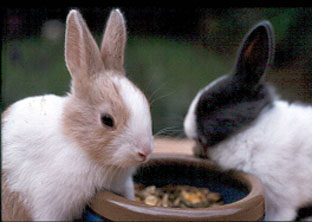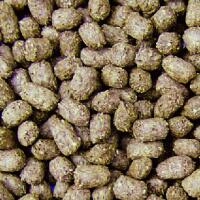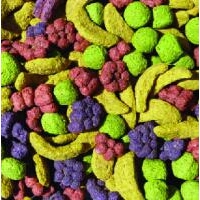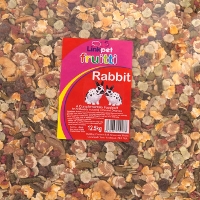- Home
- FAQs
- Customer Video Gallery
- Customer Photo Gallery
- Bird Facts
- Bird Food Blog
- Bird Information
- Feeding Advice
- Small Animal Information
- A to Z of Guinea Pigs
- A to Z of Hamsters
- A to Z of Rabbits
- Basic Care for Guinea Pigs
- Basic Care for Hamsters
- Basic Care for Rabbits
- Basic care for Chinchillas
- Basic care for Ferrets
- Basic care for Gerbils
- Basic care for Mice
- Basic care for Rats
- Buying a Healthy Small Animal
- Does your Reptile need a Licence
- Equipment for Ferrets
- Equipment for Hamsters
- Equipment for Mice
- Equipment for your Chinchilla
- Equipment for your Gerbil
- Equipment for your Guinea Pig
- Equipment for your Rabbit
- Keeping a House Rabbit
- Dog Information
- Cat Information
- Customer Information
- Fat Balls
- Suet Pellets
- Straights
- Seed Mixes
- Suet Treats
- Mealworms
- Bird Feeders
- My Account
Basic Care for Rabbits
Bunnies are very cute to look at and can make wonderful pets – provided you give them everything they need to stay happy and healthy.
Rabbits have been on Earth for around three and a half million years and it is known that they inhabited Great Britain some 22,000 years ago, due to the discovery of fossilised remains. However, their presence here was not officially acknowledged until the 11th century when the Normans invaded, bringing bunnies with them to provide food and clothing for the troops. Today, with around 1.6 million of them residing as pets in the UK, the rabbit is one of the most popular small animal companions.
Housing and bedding
When buying a hutch or cage, remember it is where most rabbits spend the majority of their lives so buy the biggest bunny abode you can afford, preferably with separate living and sleeping quarters to make your pet’s life more comfortable and pleasant. The sleeping area should be large enough for your pet to lie down and stretch out. To house two rabbits, for example, the hutch size should be a minimum of 150cm long, 75cm wide and 75cm high from floor to roof; anything smaller will not provide them with the space they need for health and happiness.
A secure run, or grazing ark, either attached to the hutch or separate, is a must-buy to give your rabbit a safe space for daily outdoor exercise – and to satisfy his burrowing instinct – on a grassy patch in fine weather.
If you intend to keep your rabbit outdoors, purchase a hutch that is sturdy, weatherproof, draught-free and without any dangerous protrusions. Opt for one raised on legs to help stop rising damp as well as wild rodents entering to steal food and spread disease. Site the hutch in a sheltered position, facing away from prevailing wind and direct sunlight – a hutch can turn into an oven during hot weather or a freezer in cold! A temperature range of 10-18c (50-64.4f) suits rabbits, although they are able to withstand considerable variations either side of these limits. Rabbits are at risk from heat exhaustion when temperatures rise above 26.4c(80f).
Line your hutch with old newspapers and cover with suitable bedding such as hay, untreated softwood shavings, straw or clean shredded paper. During winter months, ensure there is extra bedding in his sleeping quarters to keep your pet warm; in severe weather, either put the hutch in a shed or place extra insulation around it (such as wooden boarding).
Cages can be used to house rabbits indoors and these are generally of a wire mesh construction, including the floor, as this allows droppings and urine to drop through into a newspaper- or cat litter-lined tray beneath for easy cleaning. You’ll also need to supply a large nesting/sleeping box for privacy and a feeling of security when required; this should be large enough for your pet(s) to lie down and stretch out. Don’t forget to site the cage away from direct heat sources, such as radiators and sunlit areas. It distresses many small animals to be near TV sets, computers, washing machines and other electrical field/noisy household appliances, so bear this mind when deciding where to put your rabbit.
Completely clean out your rabbit's hutch (or litter tray) at least twice per week, more often if necessary, using a pet disinfectant to promote health and hygiene. Rabbits urinate copiously but if you keep your pet’s hutch clean enough, he won’t smell.
Rabbits may be kept singly but one on his own will need lots of daily attention from you to prevent him becoming bored and lonely. Two bunnies will provide company for each other and amuse themselves, however as adults of the same sex often fight, and a pair of the opposite sex will breed prolifically, you’ll need to have them neutered. Neutering reduces aggression as well as preventing breeding, but it isn’t cheap at around £40 per female and £30 per male. The best (and cheapest) option is have a female and a neutered male.
Tip: If you need to weatherproof your hutch, use a treatment that is non-toxic to animals as rabbits are notorious chewers.
Tip: It is often thought that a rabbit and a guinea pig make good hutch companions but this is not necessarily the case as the rabbit may bully the guinea pig. If you want to keep one of each species together, get both as babies so they grow up together – a male guinea pig and female rabbit are generally considered the best combination. Feed a commercial guinea pig mix (which contains the additional vitamin C that cavies require) to both.
Grooming
Brushing short-haired rabbits regularly is unnecessary since they manage a good job of it themselves. However, grooming doesn’t do any harm and is beneficial in three ways: it can help to promote healthy skin and a good coat condition; it helps ensure you detect any injuries or signs of illness early; and it may increase the bond between you and your pet.
Long-haired breeds, such as the Angora, require daily brushing to prevent the fur from matting. Use a soft grooming brush, or a grooming glove/mitt, both of which are available from pet stores.
Tip: When handling rabbits, never pick them up by the ears or you will cause them pain. To pick your pet up, hold him under his chest and forelegs and support his bottom with your other hand. Hold him close to you so he feels secure. It’s safer to pick rabbits up while you are sitting or kneeling; if a rabbit manages to wriggle out of your grip while you are standing and falls to the floor, he could badly injure himself. Rabbits do not bounce well!
Feeding
Rabbits are herbivores, which means they eat only vegetable matter. To make life simple for the novice rabbit owner, there are many commercial rabbit foods (mixes and pellets) available that supply all the essential nutrients your pet needs. Some brands may contain animal derivatives (such as fish meal) so if you want to ensure your rabbit receives a totally vegetarian diet, check the ingredients listed on the label.
Twootz provides Fruity Rabbit food, Premium Rabbit Food and Small Animal fruity mix which are both ideal for your Rabbits well being.
Avoid refilling your rabbit's bowl until it is empty as this will discourage him from becoming selective and receiving an imbalanced diet. Remember that ready-mixed foods are usually complementary, which means that they need to be fed alongside a daily supply of clean, fresh hay and water.
Fresh fruit and vegetables, along with herbage gathered from the garden (such as grass, dandelions, clover, coltsfoot and shepherd’s purse), may be fed daily in small amounts but ensure they are thoroughly washed before feeding to remove traces of dirt and pesticide.
Tip: Use heavy, non-chewable feed bowls so that your rabbit cannot tip them over easily, plus a gravity-feed water bottle for a constant supply of clean, fresh water.
Exercise
Rabbits are energetic creatures and require lots of daily exercise to help prevent obesity and keep them in good condition mentally and physically. Ensure that your pet’s exercise area is escape-proof (remember they are good jumpers) and secure from marauding cats and dogs.
Tip: Enrich your rabbit’s environment with tubes, branches, boxes, balls, etc to provide additional fun. Deciduous tree branches, such as willow, not only help keep rabbits’ teeth in good condition, they also relieve boredom by providing hours of chewing entertainment.
Health
In addition to your daily health checks, it is advisable to take your rabbit to your vet for a yearly ‘MOT’. While at the vet’s you should:
Ask your vet to show you how to trim your rabbit's claws at home, as they will need trimming regularly.
Inquire about vaccination against myxomatosis and viral haemorrhagic disease (VHD) which are fatal diseases affecting domestic rabbits.
Have your pet's teeth checked. Rabbits’ teeth grow continually and are normally worn down through chewing. However, some rabbits can suffer from overgrown teeth (malocclusion) that prevent them from eating.

Rabbits have been on Earth for around three and a half million years and it is known that they inhabited Great Britain some 22,000 years ago, due to the discovery of fossilised remains. However, their presence here was not officially acknowledged until the 11th century when the Normans invaded, bringing bunnies with them to provide food and clothing for the troops. Today, with around 1.6 million of them residing as pets in the UK, the rabbit is one of the most popular small animal companions.
Housing and bedding
When buying a hutch or cage, remember it is where most rabbits spend the majority of their lives so buy the biggest bunny abode you can afford, preferably with separate living and sleeping quarters to make your pet’s life more comfortable and pleasant. The sleeping area should be large enough for your pet to lie down and stretch out. To house two rabbits, for example, the hutch size should be a minimum of 150cm long, 75cm wide and 75cm high from floor to roof; anything smaller will not provide them with the space they need for health and happiness.
A secure run, or grazing ark, either attached to the hutch or separate, is a must-buy to give your rabbit a safe space for daily outdoor exercise – and to satisfy his burrowing instinct – on a grassy patch in fine weather.
If you intend to keep your rabbit outdoors, purchase a hutch that is sturdy, weatherproof, draught-free and without any dangerous protrusions. Opt for one raised on legs to help stop rising damp as well as wild rodents entering to steal food and spread disease. Site the hutch in a sheltered position, facing away from prevailing wind and direct sunlight – a hutch can turn into an oven during hot weather or a freezer in cold! A temperature range of 10-18c (50-64.4f) suits rabbits, although they are able to withstand considerable variations either side of these limits. Rabbits are at risk from heat exhaustion when temperatures rise above 26.4c(80f).
Line your hutch with old newspapers and cover with suitable bedding such as hay, untreated softwood shavings, straw or clean shredded paper. During winter months, ensure there is extra bedding in his sleeping quarters to keep your pet warm; in severe weather, either put the hutch in a shed or place extra insulation around it (such as wooden boarding).
Cages can be used to house rabbits indoors and these are generally of a wire mesh construction, including the floor, as this allows droppings and urine to drop through into a newspaper- or cat litter-lined tray beneath for easy cleaning. You’ll also need to supply a large nesting/sleeping box for privacy and a feeling of security when required; this should be large enough for your pet(s) to lie down and stretch out. Don’t forget to site the cage away from direct heat sources, such as radiators and sunlit areas. It distresses many small animals to be near TV sets, computers, washing machines and other electrical field/noisy household appliances, so bear this mind when deciding where to put your rabbit.
Completely clean out your rabbit's hutch (or litter tray) at least twice per week, more often if necessary, using a pet disinfectant to promote health and hygiene. Rabbits urinate copiously but if you keep your pet’s hutch clean enough, he won’t smell.
Rabbits may be kept singly but one on his own will need lots of daily attention from you to prevent him becoming bored and lonely. Two bunnies will provide company for each other and amuse themselves, however as adults of the same sex often fight, and a pair of the opposite sex will breed prolifically, you’ll need to have them neutered. Neutering reduces aggression as well as preventing breeding, but it isn’t cheap at around £40 per female and £30 per male. The best (and cheapest) option is have a female and a neutered male.
Tip: If you need to weatherproof your hutch, use a treatment that is non-toxic to animals as rabbits are notorious chewers.
Tip: It is often thought that a rabbit and a guinea pig make good hutch companions but this is not necessarily the case as the rabbit may bully the guinea pig. If you want to keep one of each species together, get both as babies so they grow up together – a male guinea pig and female rabbit are generally considered the best combination. Feed a commercial guinea pig mix (which contains the additional vitamin C that cavies require) to both.
Grooming
Brushing short-haired rabbits regularly is unnecessary since they manage a good job of it themselves. However, grooming doesn’t do any harm and is beneficial in three ways: it can help to promote healthy skin and a good coat condition; it helps ensure you detect any injuries or signs of illness early; and it may increase the bond between you and your pet.
Long-haired breeds, such as the Angora, require daily brushing to prevent the fur from matting. Use a soft grooming brush, or a grooming glove/mitt, both of which are available from pet stores.
Tip: When handling rabbits, never pick them up by the ears or you will cause them pain. To pick your pet up, hold him under his chest and forelegs and support his bottom with your other hand. Hold him close to you so he feels secure. It’s safer to pick rabbits up while you are sitting or kneeling; if a rabbit manages to wriggle out of your grip while you are standing and falls to the floor, he could badly injure himself. Rabbits do not bounce well!
Feeding
Rabbits are herbivores, which means they eat only vegetable matter. To make life simple for the novice rabbit owner, there are many commercial rabbit foods (mixes and pellets) available that supply all the essential nutrients your pet needs. Some brands may contain animal derivatives (such as fish meal) so if you want to ensure your rabbit receives a totally vegetarian diet, check the ingredients listed on the label.
Twootz provides Fruity Rabbit food, Premium Rabbit Food and Small Animal fruity mix which are both ideal for your Rabbits well being.
Avoid refilling your rabbit's bowl until it is empty as this will discourage him from becoming selective and receiving an imbalanced diet. Remember that ready-mixed foods are usually complementary, which means that they need to be fed alongside a daily supply of clean, fresh hay and water.
Fresh fruit and vegetables, along with herbage gathered from the garden (such as grass, dandelions, clover, coltsfoot and shepherd’s purse), may be fed daily in small amounts but ensure they are thoroughly washed before feeding to remove traces of dirt and pesticide.
Tip: Use heavy, non-chewable feed bowls so that your rabbit cannot tip them over easily, plus a gravity-feed water bottle for a constant supply of clean, fresh water.
Exercise
Rabbits are energetic creatures and require lots of daily exercise to help prevent obesity and keep them in good condition mentally and physically. Ensure that your pet’s exercise area is escape-proof (remember they are good jumpers) and secure from marauding cats and dogs.
Tip: Enrich your rabbit’s environment with tubes, branches, boxes, balls, etc to provide additional fun. Deciduous tree branches, such as willow, not only help keep rabbits’ teeth in good condition, they also relieve boredom by providing hours of chewing entertainment.
Health
In addition to your daily health checks, it is advisable to take your rabbit to your vet for a yearly ‘MOT’. While at the vet’s you should:
Ask your vet to show you how to trim your rabbit's claws at home, as they will need trimming regularly.
Inquire about vaccination against myxomatosis and viral haemorrhagic disease (VHD) which are fatal diseases affecting domestic rabbits.
Have your pet's teeth checked. Rabbits’ teeth grow continually and are normally worn down through chewing. However, some rabbits can suffer from overgrown teeth (malocclusion) that prevent them from eating.









